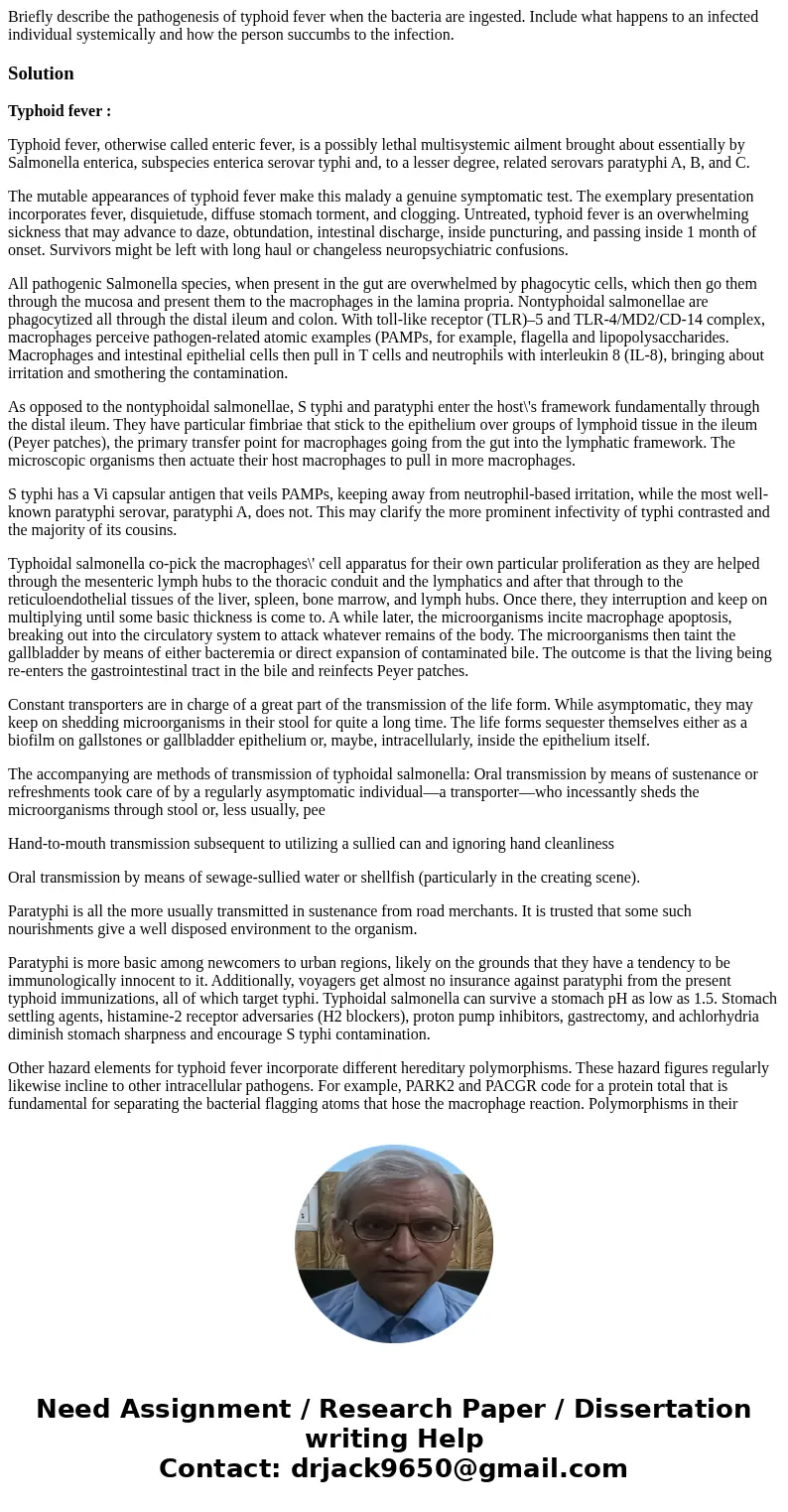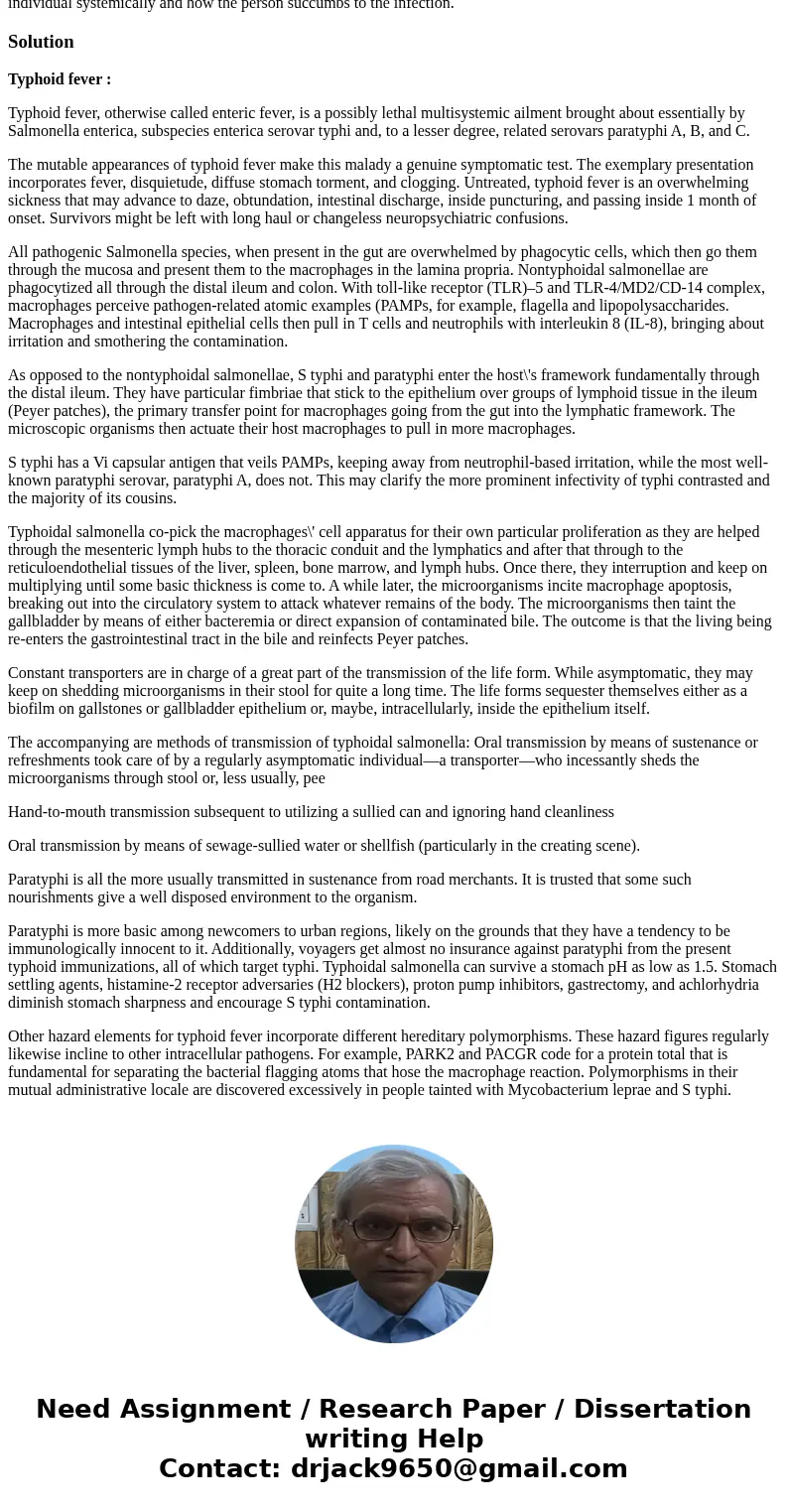Briefly describe the pathogenesis of typhoid fever when the
Briefly describe the pathogenesis of typhoid fever when the bacteria are ingested. Include what happens to an infected individual systemically and how the person succumbs to the infection.
Solution
Typhoid fever :
Typhoid fever, otherwise called enteric fever, is a possibly lethal multisystemic ailment brought about essentially by Salmonella enterica, subspecies enterica serovar typhi and, to a lesser degree, related serovars paratyphi A, B, and C.
The mutable appearances of typhoid fever make this malady a genuine symptomatic test. The exemplary presentation incorporates fever, disquietude, diffuse stomach torment, and clogging. Untreated, typhoid fever is an overwhelming sickness that may advance to daze, obtundation, intestinal discharge, inside puncturing, and passing inside 1 month of onset. Survivors might be left with long haul or changeless neuropsychiatric confusions.
All pathogenic Salmonella species, when present in the gut are overwhelmed by phagocytic cells, which then go them through the mucosa and present them to the macrophages in the lamina propria. Nontyphoidal salmonellae are phagocytized all through the distal ileum and colon. With toll-like receptor (TLR)–5 and TLR-4/MD2/CD-14 complex, macrophages perceive pathogen-related atomic examples (PAMPs, for example, flagella and lipopolysaccharides. Macrophages and intestinal epithelial cells then pull in T cells and neutrophils with interleukin 8 (IL-8), bringing about irritation and smothering the contamination.
As opposed to the nontyphoidal salmonellae, S typhi and paratyphi enter the host\'s framework fundamentally through the distal ileum. They have particular fimbriae that stick to the epithelium over groups of lymphoid tissue in the ileum (Peyer patches), the primary transfer point for macrophages going from the gut into the lymphatic framework. The microscopic organisms then actuate their host macrophages to pull in more macrophages.
S typhi has a Vi capsular antigen that veils PAMPs, keeping away from neutrophil-based irritation, while the most well-known paratyphi serovar, paratyphi A, does not. This may clarify the more prominent infectivity of typhi contrasted and the majority of its cousins.
Typhoidal salmonella co-pick the macrophages\' cell apparatus for their own particular proliferation as they are helped through the mesenteric lymph hubs to the thoracic conduit and the lymphatics and after that through to the reticuloendothelial tissues of the liver, spleen, bone marrow, and lymph hubs. Once there, they interruption and keep on multiplying until some basic thickness is come to. A while later, the microorganisms incite macrophage apoptosis, breaking out into the circulatory system to attack whatever remains of the body. The microorganisms then taint the gallbladder by means of either bacteremia or direct expansion of contaminated bile. The outcome is that the living being re-enters the gastrointestinal tract in the bile and reinfects Peyer patches.
Constant transporters are in charge of a great part of the transmission of the life form. While asymptomatic, they may keep on shedding microorganisms in their stool for quite a long time. The life forms sequester themselves either as a biofilm on gallstones or gallbladder epithelium or, maybe, intracellularly, inside the epithelium itself.
The accompanying are methods of transmission of typhoidal salmonella: Oral transmission by means of sustenance or refreshments took care of by a regularly asymptomatic individual—a transporter—who incessantly sheds the microorganisms through stool or, less usually, pee
Hand-to-mouth transmission subsequent to utilizing a sullied can and ignoring hand cleanliness
Oral transmission by means of sewage-sullied water or shellfish (particularly in the creating scene).
Paratyphi is all the more usually transmitted in sustenance from road merchants. It is trusted that some such nourishments give a well disposed environment to the organism.
Paratyphi is more basic among newcomers to urban regions, likely on the grounds that they have a tendency to be immunologically innocent to it. Additionally, voyagers get almost no insurance against paratyphi from the present typhoid immunizations, all of which target typhi. Typhoidal salmonella can survive a stomach pH as low as 1.5. Stomach settling agents, histamine-2 receptor adversaries (H2 blockers), proton pump inhibitors, gastrectomy, and achlorhydria diminish stomach sharpness and encourage S typhi contamination.
Other hazard elements for typhoid fever incorporate different hereditary polymorphisms. These hazard figures regularly likewise incline to other intracellular pathogens. For example, PARK2 and PACGR code for a protein total that is fundamental for separating the bacterial flagging atoms that hose the macrophage reaction. Polymorphisms in their mutual administrative locale are discovered excessively in people tainted with Mycobacterium leprae and S typhi.


 Homework Sourse
Homework Sourse